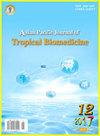从双歧Eisenia骑车提取物中分离的Dieckol抑制rankl诱导的小鼠RAW 264.7细胞的破骨细胞生成
IF 1.7
4区 医学
Q3 TROPICAL MEDICINE
引用次数: 1
摘要
目的:用RAW264.7细胞研究双环爱胜鸟dieckol对破骨细胞生成的影响。方法:对小鼠巨噬细胞RAW 264.7细胞进行dieckol处理,然后用核因子κB配体受体激活剂(RANKL)处理以诱导破骨细胞生成。使用TRAP活性试剂盒检测酒石酸抗性酸性磷酸酶(TRAP)活性。进行蛋白质印迹分析以检测破骨细胞相关因子的水平,包括TRAP和降钙素受体(CTR),转录因子,包括c-Fos、c-Jun和活化T细胞胞浆1的核因子(NFATc1)、核因子κB(NF-κB)、细胞外信号调节激酶(ERK)和c-Jun N-末端激酶(JNK)。进行免疫荧光染色以检测c-Fos、c-Jun和NFATc1的表达。结果:在双环爱胜中存在的四种根皮藤素化合物中,dieckol显著阻碍破骨细胞分化以及RANKL诱导的TRAP和CTR的表达。此外,dieckol下调c-Fos、c-Jun、NFATc1、ERK和JNK的表达水平,并抑制NF-κB信号传导。结论:Dieckol可抑制RANKL诱导的破骨细胞生成。因此,它在治疗破骨细胞生成相关疾病方面具有治疗潜力。本文章由计算机程序翻译,如有差异,请以英文原文为准。
Dieckol isolated from Eisenia bicyclis extract suppresses RANKL-induced osteoclastogenesis in murine RAW 264.7 cells
Objective: To demonstrate the effect of dieckol from Eisenia bicyclis on osteoclastogenesis using RAW 264.7 cells. Methods: Murine macrophage RAW 264.7 cells were subjected to dieckol treatment, followed by treatment with receptor activator of nuclear factor kappa-B ligand (RANKL) to induce osteoclastogenesis. Tartrate-resistant acid phosphatase (TRAP) activity was examined using a TRAP activity kit. Western blotting analysis was conducted to examine the level of osteoclast- related factors, including TRAP and calcitonin receptor (CTR), transcriptional factors, including c-Fos, c-Jun, and nuclear factor of activated T cells cytoplasmic 1 (NFATc1), nuclear factor kappa-B (NF-κB), extracellular signal-regulated kinase (ERK), and c-Jun N-terminal kinase (JNK). Immunofluorescence staining was conducted to examine the expression of c-Fos, c-Jun, and NFATc1. Results: Among the four phlorotannin compounds present in Eisenia bicyclis, dieckol significantly hindered osteoclast differentiation and expression of RANKL-induced TRAP and CTR. In addition, dieckol downregulated the expression levels of c-Fos, c-Jun, NFATc1, ERK, and JNK, and suppressed NF-κB signaling. Conclusions: Dieckol can suppress RANKL-induced osteoclastogenesis. Therefore, it has therapeutic potential in treating osteoclastogenesis- associated diseases.
求助全文
通过发布文献求助,成功后即可免费获取论文全文。
去求助
来源期刊

Asian Pacific journal of tropical biomedicine
Biochemistry, Genetics and Molecular Biology-Biochemistry, Genetics and Molecular Biology (miscellaneous)
CiteScore
3.10
自引率
11.80%
发文量
2056
审稿时长
4 weeks
期刊介绍:
The journal will cover technical and clinical studies related to health, ethical and social issues in field of biology, bacteriology, biochemistry, biotechnology, cell biology, environmental biology, microbiology, medical microbiology, pharmacology, physiology, pathology, immunology, virology, toxicology, epidemiology, vaccinology, hematology, histopathology, cytology, genetics and tropical agriculture. Articles with clinical interest and implications will be given preference.
 求助内容:
求助内容: 应助结果提醒方式:
应助结果提醒方式:


